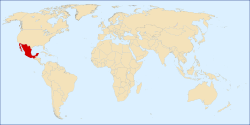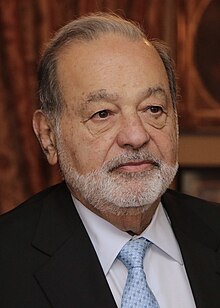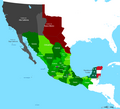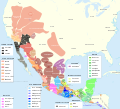Portal:Mexico
|
The Temple of Warriors at Chichen Itza, Mexico
¡Bienvenido! Welcome to the Mexico portal
Mexico, officially the United Mexican States, is a country in the southern portion of North America. It covers 1,972,550 km2 (761,610 sq mi), making it the world's 13th-largest country by area; with a population of almost 130 million, it is the 10th-most-populous country and the most populous Spanish-speaking country. Mexico is organized as a federal constitutional republic comprising 31 states and Mexico City, its capital. It shares land borders with the United States to the north, with Guatemala and Belize to the southeast; as well as maritime borders with the Pacific Ocean to the west, the Caribbean Sea to the southeast, and the Gulf of Mexico to the east.
This is a Featured article, which represents some of the best content on English Wikipedia.
Maya stelae (singular stela) are monuments that were fashioned by the Maya civilization of ancient Mesoamerica. They consist of tall, sculpted stone shafts and are often associated with low circular stones referred to as altars, although their actual function is uncertain. Many stelae were sculpted in low relief, although plain monuments are found throughout the Maya region. The sculpting of these monuments spread throughout the Maya area during the Classic Period (250–900 AD), and these pairings of sculpted stelae and circular altars are considered a hallmark of Classic Maya civilization. The earliest dated stela to have been found in situ in the Maya lowlands was recovered from the great city of Tikal in Guatemala. During the Classic Period almost every Maya kingdom in the southern lowlands raised stelae in its ceremonial centre. Stelae became closely associated with the concept of divine kingship and declined at the same time as this institution. The production of stelae by the Maya had its origin around 400 BC and continued through to the end of the Classic Period, around 900, although some monuments were reused in the Postclassic (c. 900–1521). The major city of Calakmul in Mexico raised the greatest number of stelae known from any Maya city, at least 166, although they are very poorly preserved. (Full article...)Selected article -Lesbian, gay, bisexual, and transgender (LGBT) rights in Mexico expanded in the 21st century, keeping with worldwide legal trends. The intellectual influence of the French Revolution and the brief French occupation of Mexico (1862–67) resulted in the adoption of the Napoleonic Code, which decriminalized same-sex sexual acts in 1871. Laws against public immorality or indecency, however, have been used to prosecute persons who engage in them. Tolerance of sexual diversity in certain indigenous cultures is widespread, especially among Isthmus Zapotecs and Yucatán Mayas. As the influence of foreign and domestic cultures (especially from more cosmopolitan areas such as Mexico City) grows throughout Mexico, attitudes are changing. This is most marked in the largest metropolitan areas, such as Guadalajara, Monterrey, and Tijuana, where education and access to foreigners and foreign news media are greatest. Change is slower in the hinterlands, however, and even in large cities, discomfort with change often leads to backlashes. Since the early 1970s, influenced by the United States gay liberation movement and the 1968 Tlatelolco massacre, a substantial number of LGBT organizations have emerged. Visible and well-attended LGBT marches and pride parades have occurred in Mexico City since 1979, in Guadalajara since 1996, and in Monterrey since 2001. (Full article...)Selected picture El Valle de México desde el cerro de Tenayo (1870), by Eugenio Landesio, at the Museo Nacional de Arte image credit: public domain
This is a Good article, an article that meets a core set of high editorial standards.
 The 2018 Mexico City ePrix (formally the 2018 ABB Formula E Mexico City e-Prix) was a Formula E electric car race held at the Autódromo Hermanos Rodríguez in the centre of Mexico City on 3 March 2018. It was the fifth round of the 2017–18 Formula E Championship and the third edition of the event as part of the championship. Audi driver Daniel Abt won the 47-lap race starting from fifth position. Oliver Turvey finished second for NIO and e.Dams-Renault driver Sébastien Buemi took third. Mahindra's Felix Rosenqvist won the pole position by posting the fastest lap in qualifying and led for the first 14 laps until a battery management system problem at the final corner promoted Turvey to the lead. Turvey held the lead until the mandatory pit stops to change into a second car. Swift work from Abt's pit crew moved him past Turvey who was slow leaving his garage because of a gear selection fault. Abt led the rest of the race to take his first career victory and the first for a German in Formula E. Turvey took second after holding off Buemi in the final five laps. (Full article...)Selected biography -Carlos Slim Helú (Spanish pronunciation: [ˈkaɾlos eˈslim eˈlu]; born 28 January 1940) is a Mexican business magnate, investor, and philanthropist. From 2010 to 2013, Slim was ranked as the richest person in the world by Forbes business magazine. He derived his fortune from his extensive holdings in a considerable number of Mexican companies through his conglomerate, Grupo Carso. , the Bloomberg Billionaires Index ranked him as the 11th-richest person in the world, with a net worth of $105 billion or about 7% of Mexico's GDP, making him the richest person in Latin America. Slim's corporate conglomerate spans numerous industries across the Mexican economy, including education, health care, industrial manufacturing, transportation, real estate, mass media, mining, energy, entertainment, technology, retail, sports and financial services. However, the core of his fortune derives from telecommunications, where he owns América Móvil (with operations throughout Latin America) and the Mexican carrier Telcel and ISP Telmex, a state-run-gone-private company which maintained a virtual monopoly for many years after Slim's acquisition. He accounts for 40% of the listings on the Mexican Stock Exchange, while his net worth is equivalent to about 6% of Mexico's gross domestic product. As of 2016, he is the largest single shareholder of The New York Times Company. (Full article...)
In the news
Selected fare or cuisine -
Crema is the Spanish word for cream. In the United States, or in the English language, it is sometimes referred to as crema espesa (English: "thick cream"), also referred to as crema fresca (English: "fresh cream") in Mexico. Crema fresca or crema espesa is a Mexican dairy product prepared with two ingredients, heavy cream and buttermilk. Salt and lime juice may also be used in its preparation. Crema's fat content can range between 18 and 36 percent. In Mexico, it is sold directly to consumers through ranches outside large cities, as well as being available in Mexican and Latin American grocery stores in the United States. Crema is used as a food topping, a condiment and as an ingredient in sauces. It is similar in texture and flavor to France's crème fraîche and sour cream. (Full article...)
General imagesThe following are images from various Mexico-related articles on Wikipedia.
CategoriesTopicsRelated portalsWikiProjectYou are invited to participate in WikiProject Mexico, a WikiProject dedicated to developing and improving articles about Mexico. Associated WikimediaMore portals | ||||||||||

























































































